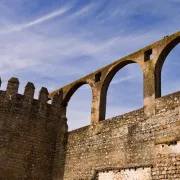
Moura is a large town in the thinly-populated (and relatively impoverished) Alentejo region. The town is supposedly named after the Moorish Princess Moura Saluquia. Legend has it that Saluquia threw herself from one of the towers of the castle after her lover was killed and she was subsequently tricked by the Portuguese, who dressed up in his clothes, into lowering the drawbridge.
The Moors' five hundred year occupation of the town ended in 1232, although they refused to relinquish their quarter until 1496 (when Dom Manuel ordered them to convert to Christianity or leave). The town's Mouraria (Moorish quarter) is one of the best-preserved in southern Portugal, consisting of an alley and three streets of narrow, cobbled lanes with low whitewashed cottages featuring strange turreted chimneys. The Mouraria is also home to the Museum Arabe, which houses a rare collection of remnants dating back to the Moorish occupation of southern Portugal. The Mouraria is at the western end of the Praca Sacardo Cabral, Moura's main square, from which everything of interest is within easy walking distance.
The church of Nossa Senhora do Carmo occupies the site of the first Carmelite convent in Portugal. It was from here that the monks left to found the Convento do Carmo in Lisbon. Nossa Senhora do Carmo has been the patron saint of Moura since the thirteenth century. The seventeenth century Igreja de Sao Pedro houses a collection of rare and valuable decorative tiles.
Once upon a time Moura was known for its fashionable spa, located within the Jardim Dr Santiago. Although bicarbonated calcium waters (said to be excellent for rheumatism) still flow from the marbled Fonte das Tres Bicas, at the time of writing the spa itself is not in use, although the gardens are a lovely place to spend an hour or so, with a bandstand and benches of elderly people chatting in the sun.

Most of Mouro's thirteenth century castle was destroyed by the Spanish in 1709. It has since been restored and offers excellent views of the surrounding countryside. One of the towers, the Torre de Tapia, is the last remnant of a Moorish fortress.
In 2008 state-owned land adjacent to Moura was selected to house the world's largest photovoltaic farm. Nearly four hundred thousand house-sized solar panels cover an area twice the size of Hyde Park in what is one of the sunniest regions of Europe.
Moura is close to the River Guadiana, where typical flat-bottomed hexagonal rowing boats are still used. Moura is also the nearest large town to what claims to be the "biggest artificial lake in Europe" created by the Alqueva Dam.

